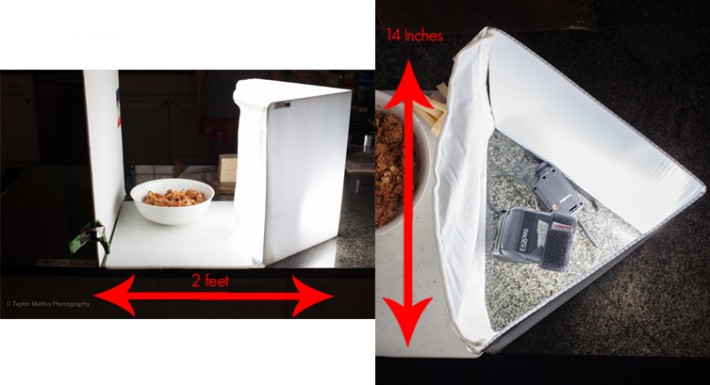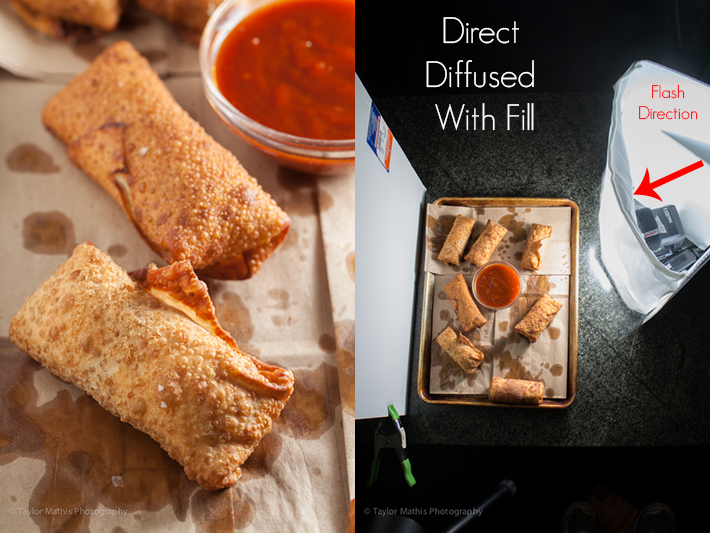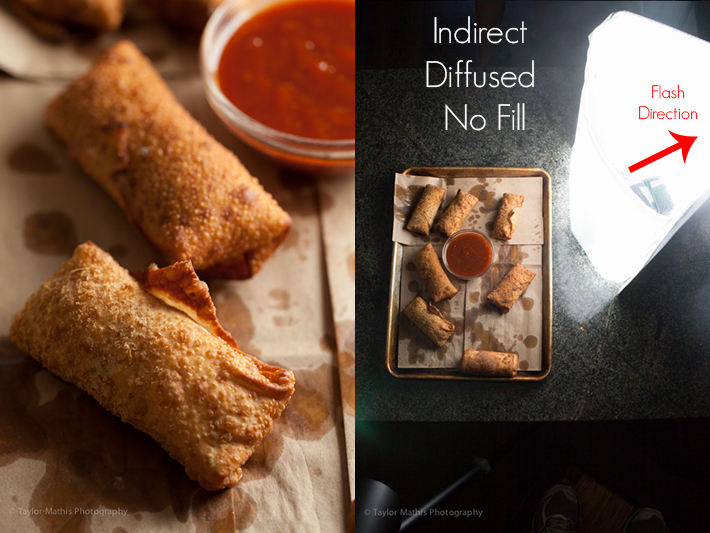When taking pictures of food in a kitchen you will almost always have to create your own lighting environment. Restaurant kitchens are usually lit by overhead fluorescent lighting that won't help you make a beautiful picture of a dish. In these situations, you will have to make your own light. There is a problem, though. What happens when the shooting space is so small that you can't fit a softbox or light stand into the kitchen? If you ever find yourself with only a counter top sized area to shoot on, this lighting set-up will create the shot you need!

You most likely already own everything that you need to create this set-up. You will need foam board or other white reflective board, a piece of diffusion material and tape.
Take the foam board or other white reflective board and cut it into two equal size pieces. Tape these two pieces together to make a V. The V should be able to stand up on its own when opened. The pieces of foam board should be large enough so that your flash can fit inside of the V. On the open portion of the V, you will tape a piece of diffusion material over the opening to create a triangle.
In the above example, I am using diffusion material from a small soft box that I already own. When stretched across the V it will create a triangle with two sides being white foam board and the third side being the white diffusion material.
This triangle soft box will sit on one side of your subject. On the other side you will need a piece of white foam board or other type of reflector. With a cutting board between my reflector and the triangle light box, it takes up about 2 feet of counter space. The size of your triangle light box is up to you. When opened, the one in the example is 14 inches wide. Choose a size that will easily fit on a counter top. The whole set-up collapses for easy travel and portability.
With this set up, you have several options on how to position your light. You can have the flash bounce off the foam board to create an indirect light source or you can have the flash fire straight through the diffusion material for a more direct light source.
Here is the set-up with fill and indirect diffused lighting. The indirect light source will give soft shadows on the subject.

Here is the set-up with fill and direct diffused lighting. Notice how the direct lighting has more defined shadows and a brighter highlights behind the egg roll.

Here is the set-up with no fill and direct diffused lighting.

If you want a fill level in between the fill and no fill look, remember that you can move a reflector closer or further away until it creates the look you desire.
Sometimes, you have no idea what shooting environment you will find yourself in. It is ideal to shoot in a large restaurant space with plenty of room to move around, but sometimes plans change and you have to be flexible.When in a bind and you have to shoot in very small working conditions, this lighting set up will help you get the look you need.
For more tips on food photography lighting tips check out issues 1-7 of photographing FOOD.







thank you :)
Taylor, I'm not into food photography at all, and yet I had to read all of your tips as they are so educational and simple.
"Less Is More"
thanks dude
Thanks Ahmad! Glad you have enjoyed the tips
The greasy paper kills it, talk about lack of presentation. While the lighting tips that have been posted are useful, I would like to see some food prep tips.
Really the greasy paper makes it for me, the photo it well composed and well lit. It looks real and not contrived.
Yes, it looks real as you say... but in general the point of photographing food is to make the viewer hungry. The oil makes my stomach turn and thus as a 'food' photo this fails, though as an image to make one go on a diet it might be successful :)
I have to agree...thats why Food Stylists exist. The photographer takes care of the lighting and composition, and the stylist makes the food and presentation look good.
Wow, does every image need to be photoshop manicured? The image to me is real, it is beautiful and the composition is great. If I want perfect pics of food I will look for them on Pinterest. Food is real food photos should represent that unless you are trying to create a catalog, menu or an add. Lighten up, a little grease on a paper towel with fried food is real.
Beside the greasy spots being gross looking to me, I find the, distracting me from the subject. You don't see greasy food spots on a high profile food advertising campaign.
Very nice, do you find a difference in using the white foam board and the cheaper plastic board for bouncing flash or using them as a diffuser?
I've used the 'flash shot into folded foam core' in many sizes, sometimes putting the subject on the inside if the reflective material is large, but never thought to put diffusion material in front of it for things outside of it. Thanks for the idea. This has to be one of the easiest setups other than a window.
Jeff
I actually like the greasy look. lol, in my experience the best tasting food is the greasy unhealthy stuff. Other than that, the tips are great! Thanks for the post.
Thanks for the info. I have stand lights but as you say, my kitchen space is limited. Thanks again
Oh Man, I have seen some great stuff about photography (from a beginners point of view) but your work in all these posts is BY-FAR THE GREATEST!!
It just shows how big eyes you have for the details..Love it. Thanks
Taylor, a person asked about lens and f/stop. Please answer, Thanks JK